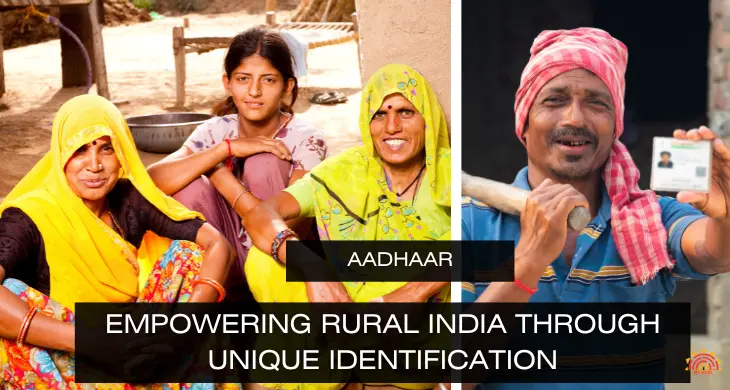In recent times, Aadhaar has emerged as a crucial tool in reshaping the socio-economic landscape of rural India. Its versatile applications have made a substantial impact on various government welfare schemes, agricultural practices, financial inclusion, and beyond. This article explores the manifold roles Aadhaar assumes in rural settings, underscoring its contributions to fostering inclusive growth and development.
Significance of Aadhaar in Rural Areas:
Aadhaar’s distinctive identification system has been a game-changer for countless rural inhabitants, granting them an official identity. This breakthrough has paved the way for easier access to a wide range of government services and subsidies, which were once cumbersome to acquire. The authentication provided by Aadhaar has streamlined processes, reducing bureaucratic hurdles for rural individuals. It has made it possible to take advantage of essential services like fiscal aid, healthcare, and education. This newfound acceptance has not only bettered their quality of life but has also fostered a sense of belonging and addition within the larger societal frame. Also, it has enabled them to share more laboriously in colorful socioeconomic conditioning thereby propelling progress and substance in pastoral India.
- Catalyzing Development and Inclusion
Aadhaar- enabled action have led to a new period for rural India, significantly enhancing access to education, healthcare, financial services, and social security benefits. This transformative shift has played a vital part in bridging the divide between civic and rural areas, guaranteeing that indeed the most remote communities have access to essential services. The Aadhaar frame has streamlined processes, making it more accessible for residents of rural India to mileage themselves of vital installations. This has not only bettered their quality of life but has also contributed to a further inclusive and indifferent society. The far- reaching impact of Aadhaar in pastoral areas is a testament to its effectiveness in addressing longstanding challenges and creating opportunities for growth and development.
- Aadhaar and Direct Benefit Transfer (DBT)
This integration, linking Aadhaar to bank accounts, has revolutionized the distribution of subsidies. It has led to a marked reduction in leakages, ensuring that government benefits are efficiently directed to the rightful recipients. This streamlined process has not only eliminated intermediaries but has also enhanced transparency and accountability in subsidy disbursement. As a result, rural residents now receive their entitled benefits directly into their bank accounts, bypassing the hurdles and delays that were prevalent in traditional distribution methods. This transformation has not only empowered rural communities but has also fortified the government’s efforts towards effective and targeted welfare schemes.
- Improving Targeting of Beneficiaries
Aadhaar’s biometric authentication has brought about a paradigm shift in the identification of beneficiaries within social welfare schemes. This technological advancement ensures that resources are allocated with unprecedented precision, guaranteeing that individuals in dire need of assistance are the primary recipients. By leveraging biometric data, Aadhaar eliminates duplication and inaccuracies in beneficiary lists, ensuring that welfare measures reach their intended targets. This efficiency not only optimizes resource utilization but also bolsters the impact of social welfare initiatives, ultimately resulting in a more inclusive and equitable support system. In essence, Aadhaar’s biometric authentication has heralded a new era of effectiveness and accountability in the implementation of social welfare programs, significantly improving the lives of those it serves.
- Financial Inclusion through Aadhaar
The integration of Aadhaar with banking services has played a vital role in advancing financial rise across rural regions. This flawless linkage has simplified the process for residents to show bank accounts, thereby enabling them to use themselves of credit facilities, insurance options, and a range of other financial products. As a result, individuals in rural areas now have enhanced access to essential fiscal services, empowering them to manage their finances more effectively and share more laboriously in the formal economy. This action has not only bolstered the profitable well- being of pastoral communities but has also contributed to the overall profitable growth and development of the nation. By bridging the gap between traditional banking systems and remote areas, Aadhaar has catalyzed a positive transformation in the financial landscape of rural India.
- Strengthening Healthcare Services
Aadhaar has been a cornerstone in enhancing healthcare provisions in rural areas. It not only allows for seamless tracking of medical histories but also streamlines the distribution of healthcare benefits. This ensures that individuals in remote regions receive healthcare services promptly and of a high standard. Through Aadhaar-enabled systems, healthcare providers can access crucial patient information, making diagnoses and treatment more accurate and efficient. Additionally, it enables the targeted delivery of government healthcare schemes and subsidies, maximizing their impact. This integrated approach has led to improved healthcare outcomes in rural communities, addressing longstanding challenges related to access and quality. Aadhaar’s influence on rural healthcare exemplifies how technology-driven solutions can positively transform essential services, ultimately benefiting the health and well-being of individuals in these regions.
- Revolutionizing Public Distribution System (PDS)
Aadhaar-enabled authentication has been a game-changer in ensuring food security through the Public Distribution System (PDS). By incorporating biometric verification, it has drastically reduced leakages and ensured that vital commodities are distributed to households in an equitable and transparent manner. This technological intervention has strengthened the effectiveness of the PDS, aligning it with the intended goal of reaching those in need. Aadhaar’s role in food security exemplifies how innovative solutions can fortify essential services, ultimately benefiting the well-being of individuals and families in rural India. The system’s success in minimizing pilferage and enhancing the integrity of food distribution has had a profound impact on the lives of millions, emphasizing the transformative eventuality of technology in governance and public welfare.
Aadhaar and MGNREGA:
The integration of Aadhaar with MGNREGA has brought significant advancements. It has directed a new period of translucency, responsibility, and effective monitoring in the prosecution of this pivotal rural employment scheme. By linking Aadhaar, the system has been fortified against fraudulent practices and assured that the intended beneficiaries receive the full benefits of the program. This integration has not only streamlined the process but also implanted trust in the perpetration of MGNREGA, bolstering its impact on the livelihoods of rural communities. The successful confluence of Aadhaar with MGNREGA stands as a testament to how technology can be abused for the betterment of rural India, amplifying the reach and effectiveness of vital government enterprise.
Education Schemes Empowered by Aadhaar:
Aadhaar has emerged as a key catalyst in enhancing attendance and enrollment rates in government schools across rural areas. It establishes a dependable framework for monitoring educational advancement, guaranteeing that children have access to a high-quality learning experience. The integration of Aadhaar in the education sector has not only simplified record-keeping but also fostered accountability among stakeholders. It enables authorities to identify and address implicit gaps in the education system, eventually contributing to an advanced overall literacy environment. By using the power of Aadhaar, the government has taken significant strides towards creating an inclusive and robust educational infrastructure in rural India, ensuring that every child has the occasion to admit a quality education, anyhow of their background or position.
Impact on Social Security Schemes:
Aadhaar has streamlined the distribution of social security benefits, particularly pensions, making the process highly efficient. By cutting out intermediaries, it guarantees that beneficiaries receive their entitled benefits directly. This direct transfer mechanism not only accelerates the delivery of crucial financial support but also minimizes the chances of misappropriation or delays. Aadhaar’s integration in the disbursal of social security benefits has significantly reduced regulatory hurdles, giving a more transparent and responsible system. It empowers donors by assuring that they’ve prompt access to the financial backing they calculate on, therefore enhancing their overall well- being and livelihoods. The Aadhaar-enabled direct benefit transfer model exemplifies a transformative approach to social welfare, emphasizing efficiency, transparency, and empowerment.
Aadhaar and Agriculture:
Aadhaar has been instrumental in empowering farmers by granting them a distinct identity. This unique identification system streamlines the execution of diverse agricultural initiatives, guaranteeing that the advantages are directed towards those actively involved in farming activities. With Aadhaar-linked agricultural schemes, farmers experience smoother accessibility to the resources and support they require for their agricultural endeavors. The integration of Aadhaar in the agricultural sector has not only simplified administrative procedures but has also fortified the foundation of agricultural development in the country. By ensuring that benefits are targeted towards the right beneficiaries, Aadhaar contributes significantly to the upliftment of the farming community, ultimately fostering growth and sustainability in the agricultural domain.
Navigating Challenges and Concerns:
Although Aadhaar’s influence has largely been positive, it is imperative to acknowledge and address privacy and security apprehensions. Upholding responsible and ethical implementation stands as a crucial priority in safeguarding the rights and personal information of individuals. Balancing the benefits of Aadhaar with robust privacy measures is essential for building and maintaining trust in the system. It is imperative for authorities to continually assess and enhance security protocols to stay ahead of potential threats. Additionally, transparent communication about data protection and privacy policies is vital to instill confidence in Aadhaar users. By doing so, Aadhaar can continue to serve as a transformative tool for empowerment while respecting and protecting the privacy of every individual.
Frequently Asked Questions:
Q. How has Aadhaar impacted access to government schemes in rural areas?
A. Aadhaar has streamlined the delivery of government services and subsidies in rural areas, reducing leakages and ensuring benefits reach the intended beneficiaries.
Q. Is Aadhaar’s impact limited to specific sectors in rural India?
A. No, Aadhaar has a wide-ranging impact across sectors including agriculture, food security, social security, and more, positively influencing rural livelihoods.
Q. Are there any privacy concerns associated with Aadhaar in rural areas?
A. While Aadhaar has brought immense benefits, it’s important to address privacy and security concerns to protect individuals’ rights and information.
Q. How can Aadhaar further contribute to the development of rural India?
A. Aadhaar’s continued evolution and responsible implementation are key to shaping an inclusive and prosperous future for rural communities.
Q. What impact has Aadhaar had on rural employment schemes like MGNREGA?
A. Aadhaar integration has enhanced transparency, accountability, and monitoring in the implementation of MGNREGA, a critical rural employment scheme.
Conclusion:
Aadhaar’s impact on rural India is monumental. It has heralded an era of inclusive growth, providing rural citizens access to vital services and government initiatives. The transformative power of Aadhaar in rural areas is inarguable, and its influence is set to continue. As Aadhaar adapts and grows, it’s poised to play an indeed more significant part in shaping a future that’s inclusive, prosperous, and responsive to the requirements of rural communities. The commission it brings to rural residents is a testament to the eventuality of well- designed, tech- enabled results in driving positive change in the lives of millions across India’s vast rural geography.

